How do you know that? If he is deceptive in his bidding practice, he could do the same with the info he gave on the bull. Dishonesty is a habit. If I know someone has practiced dishonest business with others, I steer clear of them. There are registered cattle I won't even consider because of the breeder reputation, not the bloodlines or performance data.No, he was bidding against someone else to get the minimum amount he wanted. After the bull basically no-saled, he offered him to us after the sale because we had shown earlier interest. I know he was deceptive in his bidding practice, but it wasn't against us.
You are using an out of date browser. It may not display this or other websites correctly.
You should upgrade or use an alternative browser.
You should upgrade or use an alternative browser.
Max price on a Bull for commercial use
- Thread starter Josher
- Start date

Help Support CattleToday:
Peace
Well-known member
Sounds like the start of the, old Harvestore Silo pitch....
Why focus on price?
Because controlling input expenses is a means of increasing profit margins.
Why build a bunker silo when you can have a big beautiful Blue Harvestore Silo?
Except you missed the part about you could buy very good bulls from $2700 to $3500 that have the same potential, per EPDs, as the $10k and up bulls....
SimAngus farmer
Member
I am soon to be in the market for a new bull and have enjoyed following this thread.
The bulls that I will be looking at first are reg. angus AI sons of Enhance. 2 of the 3 I have narrowed down have all $values in the top 25% or better. I expect to pay more than I have ever paid before.
This has been my thought process or maybe my way of justifying something that I want.
I am a commercial producer and participate in the Simmental Association's THE program. I enjoy collecting data and while I know EPD's are not an exact science, I believe it's a good tool.
After looking back at the last (2) bulls I have purchased and their calves performance thus far, I found that calves sired by my current (2) bulls average +55# and +52# heavier at weaning than their predecessors calves.
The average extra pounds at weaning x number of calves sired so far=2585# and 1612# respectively.
Those weights x avg. $ per lb. sold for last year= $3282.95 and $2047.24 respectively.
So in my simple mind, I could afford to pay that much more than an average priced bull and be somewhere around even in the long run.
I also gain the "projected" increased value in their daughters as a bonus.
As someone else mentioned, long term goals play a part. I am striving to eventually provide high quality, functional, commercial females with similar data as registered producers provide. It won't matter to all prospective buyers, but for those that desire the data, I hope to be their choice.
The fastest way I can see to turn my average-below breed average cow herd into an above breed average herd is by using the very best bulls that I can source. I hope that after I have raised the overall quality of my dams EPD's that I can begin to use more moderate bulls to hold above average performance without drifting towards extremes. Again, I know EPD's are not the be-all, end-all, but I choose to start with the data and cull from there.
I would like to hear comments or constructive criticism about my plan and how to get there.
The bulls that I will be looking at first are reg. angus AI sons of Enhance. 2 of the 3 I have narrowed down have all $values in the top 25% or better. I expect to pay more than I have ever paid before.
This has been my thought process or maybe my way of justifying something that I want.
I am a commercial producer and participate in the Simmental Association's THE program. I enjoy collecting data and while I know EPD's are not an exact science, I believe it's a good tool.
After looking back at the last (2) bulls I have purchased and their calves performance thus far, I found that calves sired by my current (2) bulls average +55# and +52# heavier at weaning than their predecessors calves.
The average extra pounds at weaning x number of calves sired so far=2585# and 1612# respectively.
Those weights x avg. $ per lb. sold for last year= $3282.95 and $2047.24 respectively.
So in my simple mind, I could afford to pay that much more than an average priced bull and be somewhere around even in the long run.
I also gain the "projected" increased value in their daughters as a bonus.
As someone else mentioned, long term goals play a part. I am striving to eventually provide high quality, functional, commercial females with similar data as registered producers provide. It won't matter to all prospective buyers, but for those that desire the data, I hope to be their choice.
The fastest way I can see to turn my average-below breed average cow herd into an above breed average herd is by using the very best bulls that I can source. I hope that after I have raised the overall quality of my dams EPD's that I can begin to use more moderate bulls to hold above average performance without drifting towards extremes. Again, I know EPD's are not the be-all, end-all, but I choose to start with the data and cull from there.
I would like to hear comments or constructive criticism about my plan and how to get there.
I have been thinking about this thread for a couple days now trying to compose my thoughts as I just went thru this debate not long ago. Here is my take.
Growing up we never has high dollar bulls. The were good at what they did but nothing fancy. I kept that mentality going when I started managing some other people's cattle on both the cow and bull side.
After running the formula I posted and looking at bulls I realized it was not adding that much more per calf to try a more expensive bull, which is $5K for us, up from our $2-3k avg. We decided to take a gamble and try it.
I can say after going to well known breeders and paying for the more expensive bulls I firmly believe they justified their added cost. We are getting more, better (mo-betta) quality calves. My choices of replacement quality heifers are up as a percentage. Then by keeping them and breeding back again to these bulls I'm seeing some really nice animals.
I'm not saying you have to spend that money to get good bulls but I do believe it's easier to get good bulls if you pay a little more and they will justify their cost from what I have seen. Another thing I will add, when buying these bulls that are more expensive from reputable breeders they are putting a warranty on them. I've actually tested that warranty twice in the last couple of years and both operations honored their word. I know that is built in to the price and I am ok with that.
Growing up we never has high dollar bulls. The were good at what they did but nothing fancy. I kept that mentality going when I started managing some other people's cattle on both the cow and bull side.
After running the formula I posted and looking at bulls I realized it was not adding that much more per calf to try a more expensive bull, which is $5K for us, up from our $2-3k avg. We decided to take a gamble and try it.
I can say after going to well known breeders and paying for the more expensive bulls I firmly believe they justified their added cost. We are getting more, better (mo-betta) quality calves. My choices of replacement quality heifers are up as a percentage. Then by keeping them and breeding back again to these bulls I'm seeing some really nice animals.
I'm not saying you have to spend that money to get good bulls but I do believe it's easier to get good bulls if you pay a little more and they will justify their cost from what I have seen. Another thing I will add, when buying these bulls that are more expensive from reputable breeders they are putting a warranty on them. I've actually tested that warranty twice in the last couple of years and both operations honored their word. I know that is built in to the price and I am ok with that.
Son of Butch
Well-known member
yupDishonesty is a habit. ....... steer clear of them.
callmefence
Keyboard cowboy
Seems like the fastest way to improve below average cows would be to trade them in on better cows.I am soon to be in the market for a new bull and have enjoyed following this thread.
The bulls that I will be looking at first are reg. angus AI sons of Enhance. 2 of the 3 I have narrowed down have all $values in the top 25% or better. I expect to pay more than I have ever paid before.
This has been my thought process or maybe my way of justifying something that I want.
I am a commercial producer and participate in the Simmental Association's THE program. I enjoy collecting data and while I know EPD's are not an exact science, I believe it's a good tool.
After looking back at the last (2) bulls I have purchased and their calves performance thus far, I found that calves sired by my current (2) bulls average +55# and +52# heavier at weaning than their predecessors calves.
The average extra pounds at weaning x number of calves sired so far=2585# and 1612# respectively.
Those weights x avg. $ per lb. sold for last year= $3282.95 and $2047.24 respectively.
So in my simple mind, I could afford to pay that much more than an average priced bull and be somewhere around even in the long run.
I also gain the "projected" increased value in their daughters as a bonus.
As someone else mentioned, long term goals play a part. I am striving to eventually provide high quality, functional, commercial females with similar data as registered producers provide. It won't matter to all prospective buyers, but for those that desire the data, I hope to be their choice.
The fastest way I can see to turn my average-below breed average cow herd into an above breed average herd is by using the very best bulls that I can source. I hope that after I have raised the overall quality of my dams EPD's that I can begin to use more moderate bulls to hold above average performance without drifting towards extremes. Again, I know EPD's are not the be-all, end-all, but I choose to start with the data and cull from there.
I would like to hear comments or constructive criticism about my plan and how to get there.
SimAngus farmer
Member
Your statement is correct.
And maybe I should clarify that most of my cows are "average/below-average" from an epd standpoint such as their API or TI number. All of my cows are expected to wean a good calf each year on grass, hay and mineral. I rarely supplement them and only if my management has caused the deficiency.
I think that without any epd's to look at, my herd would pass muster for my area.
When I was talking to the ASA about enrolling in "THE", the person on the phone said I should look at J. DAVIS Cattle as a producer that was already doing what I was describing. His operation is exactly what I am striving to accomplish some day.
So, I could sell all of my cows and drive up to the Carolinas as a source to restock my pastures, but I'm more of a see if I can do it kind of person.
I do hope I can meet Mr. Davis some day. I have a few questions that maybe only he can answer. Meanwhile, I'm enjoying the process.
I may very well look back years from now and say, I shoulda listened to callmefence and just bought different cows.
And maybe I should clarify that most of my cows are "average/below-average" from an epd standpoint such as their API or TI number. All of my cows are expected to wean a good calf each year on grass, hay and mineral. I rarely supplement them and only if my management has caused the deficiency.
I think that without any epd's to look at, my herd would pass muster for my area.
When I was talking to the ASA about enrolling in "THE", the person on the phone said I should look at J. DAVIS Cattle as a producer that was already doing what I was describing. His operation is exactly what I am striving to accomplish some day.
So, I could sell all of my cows and drive up to the Carolinas as a source to restock my pastures, but I'm more of a see if I can do it kind of person.
I do hope I can meet Mr. Davis some day. I have a few questions that maybe only he can answer. Meanwhile, I'm enjoying the process.
I may very well look back years from now and say, I shoulda listened to callmefence and just bought different cows.
callmefence
Keyboard cowboy
Nice to meet you sir..Your statement is correct.
And maybe I should clarify that most of my cows are "average/below-average" from an epd standpoint such as their API or TI number. All of my cows are expected to wean a good calf each year on grass, hay and mineral. I rarely supplement them and only if my management has caused the deficiency.
I think that without any epd's to look at, my herd would pass muster for my area.
When I was talking to the ASA about enrolling in "THE", the person on the phone said I should look at J. DAVIS Cattle as a producer that was already doing what I was describing. His operation is exactly what I am striving to accomplish some day.
So, I could sell all of my cows and drive up to the Carolinas as a source to restock my pastures, but I'm more of a see if I can do it kind of person.
I do hope I can meet Mr. Davis some day. I have a few questions that maybe only he can answer. Meanwhile, I'm enjoying the process.
I may very well look back years from now and say, I shoulda listened to callmefence and just bought different cows.
simme
Old Dumb Guy
Joe Davis' father was the principal of my school growing up and we went to the same church. Don't know if that qualifies me to respond or not. EPD's are a tool to predict performance/quality. EPD's also have an associated accuracy for each cow and trait that can help you decide how much you should trust the number for that cow. If your cows are commercial non-registered animals, their EPD's are initially assigned by the ASA based solely of breed composition. Say you purchase a black baldy cow of undocumented parentage and enroll her in the ASA THE program. You state that she if 1/2 Hereford and 1/2 Angus since that may be all you know or think you know about the genetics. You don't know the specific Hereford sire or Angus dam. The ASA will assign EPD's based on breed average Hereford and Angus EPD's and the accuracies will be very low. If you know the specific Hereford sire, you can provide that info and get better EPD's and accuracy. Over much time and generations of being in the program with lots of data on calves reported for a long time, the accuracies will go up and better reflect the genetic potential of the cows. I say all of that to get to my point. Unless your "below average" commercial cows have several generations of EPD's associated with them, don't be concerned about the EPD's yet. Keep and cull based in actual performance and visual. Weaning weight ratio for a calf is 100% accurate if you use scales. It is realtime right now. EPD accuracies will take a while to catch up. Conclusion - don't worry about below average EPD's at this time. You don't know if they are below average or not with their low accuracy. Don't replace your cows due to below average EPD's.Your statement is correct.
And maybe I should clarify that most of my cows are "average/below-average" from an epd standpoint such as their API or TI number. All of my cows are expected to wean a good calf each year on grass, hay and mineral. I rarely supplement them and only if my management has caused the deficiency.
I think that without any epd's to look at, my herd would pass muster for my area.
When I was talking to the ASA about enrolling in "THE", the person on the phone said I should look at J. DAVIS Cattle as a producer that was already doing what I was describing. His operation is exactly what I am striving to accomplish some day.
So, I could sell all of my cows and drive up to the Carolinas as a source to restock my pastures, but I'm more of a see if I can do it kind of person.
I do hope I can meet Mr. Davis some day. I have a few questions that maybe only he can answer. Meanwhile, I'm enjoying the process.
I may very well look back years from now and say, I shoulda listened to callmefence and just bought different cows.
TCFRH
Well-known member
Because he told us he did it. The bull we got from him was a resale, they bought him from a very reputable breeder, and I have genetic evidence he is what his papers say he is, so I'm comfortable with the deal we made. I won't do business with him again though because he did have some other deceptive practices when transferring him to us that I had to reconcile myself with AHA. Live and learn.How do you know that? If he is deceptive in his bidding practice, he could do the same with the info he gave on the bull. Dishonesty is a habit. If I know someone has practiced dishonest business with others, I steer clear of them. There are registered cattle I won't even consider because of the breeder reputation, not the bloodlines or performance data.
SimAngus farmer
Member
Thanks for the reply. I had forgotten about the cow summary and other reports on the herdbook site.Joe Davis' father was the principal of my school growing up and we went to the same church. Don't know if that qualifies me to respond or not. EPD's are a tool to predict performance/quality. EPD's also have an associated accuracy for each cow and trait that can help you decide how much you should trust the number for that cow. If your cows are commercial non-registered animals, their EPD's are initially assigned by the ASA based solely of breed composition. Say you purchase a black baldy cow of undocumented parentage and enroll her in the ASA THE program. You state that she if 1/2 Hereford and 1/2 Angus since that may be all you know or think you know about the genetics. You don't know the specific Hereford sire or Angus dam. The ASA will assign EPD's based on breed average Hereford and Angus EPD's and the accuracies will be very low. If you know the specific Hereford sire, you can provide that info and get better EPD's and accuracy. Over much time and generations of being in the program with lots of data on calves reported for a long time, the accuracies will go up and better reflect the genetic potential of the cows. I say all of that to get to my point. Unless your "below average" commercial cows have several generations of EPD's associated with them, don't be concerned about the EPD's yet. Keep and cull based in actual performance and visual. Weaning weight ratio for a calf is 100% accurate if you use scales. It is realtime right now. EPD accuracies will take a while to catch up. Conclusion - don't worry about below average EPD's at this time. You don't know if they are below average or not with their low accuracy. Don't replace your cows due to below average EPD's.
I did turn in tissue samples, mature weights and hip heights when I entered my cow herd in to THE. Accuracies are still pretty low after that, but higher than they were initially.
Do you believe that there can be value captured in the higher priced bulls for long term benefits?
Son of Butch
Well-known member
Absolutely, but the problem is identifying which higher priced bulls they are and to accomplish it in a cost effective manner. That's why highly Proven A.I. bulls are so valuable. Studs buy or lease a lot of high priced young sires every year, only to have the majority of them 'wash out' of their lineup when the results come in.I had forgotten about the cow summary and other reports on the herdbook site.
Do you believe that there can be value captured in the higher priced bulls for long term benefits?
simme
Old Dumb Guy
Stated another way - Can higher quality bulls provide value in the long term. I think the answer to that has to be YES. The key there is selecting a high quality bull. High price does not guarantee high quality just as low price does not guarantee low quality. But, on average there is a positive correlation since a perceived higher quality bull will have more demand relative to supply due to evaluation by the buyers. If he looks better, performed better, has better relatives, better numbers, etc, then most people are going to decide he is better and he sells for more money. And many times turns out to be the case, but no guarantee.Do you believe that there can be value captured in the higher priced bulls for long term benefits?
Think about making progress and improving each generation. So, if you have excellent cows with great performance all around, it will take a heck of a bull to improve them. And a heck of a price probably. If you have lower quality cows, you can make improvement with a much lower quality bull and then increase bull quality as you increase cow quality if that is your goal. Does anyone need a $10,000 bull to breed to mediocre cows? If someone achieves a near perfect cow herd, it may be difficult to buy a bull that will improve them. At that point, there should be several bull calves in the herd that will suffice.
From a profit standpoint, everyone has to figure that out for themselves. Too many variables. Cost of a bull compared to increase or decrease in profit has to be considered. Why spend more or less if you end up making less money? It is possible that buying a high dollar bull could make you less money, but also possible that buying a very cheap bull could have the same effect.
I am amused at the descriptions in the AI catalogs when I read that a bull will moderate frame. If the bull is a 5 frame, I would expect he would moderate frame on a 6 or 7 frame cow. But probably not on a 3 frame cow. Point is to select a bull based on your cows and your goals, not what someone says. Seek advice and opinions, not decisions and direction. When you get it all figured out, then you will probably be too old to put it in place. Life is a journey and adventure.
Last edited:
Lee VanRoss
Well-known member
- Joined
- Apr 26, 2020
- Messages
- 2,392
- Reaction score
- 2,682
It has been my (limited) experience that if you can get a bull bought in the first 25% of the bulls sold at a breeder auction
you stand a much better chance at a decent bull.. Normally the breeder will 'put his best foot forward' so the odds are in
your favor much more than in the later offerings.
you stand a much better chance at a decent bull.. Normally the breeder will 'put his best foot forward' so the odds are in
your favor much more than in the later offerings.
Sounds like a practical plan that makes sense. EPD's tend to get beat up on because folks take them to literal at times. As you mention, it's just more data to help us balance and consider the decisions we make - to not use them is a big mistake. Depending on how they're used, they can help us or they can hurt us (lots of big numbered bulls out there that look absolutely horrible and sire animals that look horrible) in the seedstock business, if your not staying towards the higher end numbers on desirable traits, you get left behind usually (the newer $C epd for angus has helped to keep a bit of a balance) - if you're raising commercial animals, it's not so critical when you market them as no one looks at pedigree per se.I am soon to be in the market for a new bull and have enjoyed following this thread.
The bulls that I will be looking at first are reg. angus AI sons of Enhance. 2 of the 3 I have narrowed down have all $values in the top 25% or better. I expect to pay more than I have ever paid before.
This has been my thought process or maybe my way of justifying something that I want.
I am a commercial producer and participate in the Simmental Association's THE program. I enjoy collecting data and while I know EPD's are not an exact science, I believe it's a good tool.
After looking back at the last (2) bulls I have purchased and their calves performance thus far, I found that calves sired by my current (2) bulls average +55# and +52# heavier at weaning than their predecessors calves.
The average extra pounds at weaning x number of calves sired so far=2585# and 1612# respectively.
Those weights x avg. $ per lb. sold for last year= $3282.95 and $2047.24 respectively.
So in my simple mind, I could afford to pay that much more than an average priced bull and be somewhere around even in the long run.
I also gain the "projected" increased value in their daughters as a bonus.
As someone else mentioned, long term goals play a part. I am striving to eventually provide high quality, functional, commercial females with similar data as registered producers provide. It won't matter to all prospective buyers, but for those that desire the data, I hope to be their choice.
The fastest way I can see to turn my average-below breed average cow herd into an above breed average herd is by using the very best bulls that I can source. I hope that after I have raised the overall quality of my dams EPD's that I can begin to use more moderate bulls to hold above average performance without drifting towards extremes. Again, I know EPD's are not the be-all, end-all, but I choose to start with the data and cull from there.
I would like to hear comments or constructive criticism about my plan and how to get there.
Enhance sires awesome cattle so seems like a good choice there.
farmerjan
Well-known member
Hoser
Well-known member
That's what I did this year. I became much more picky and paid 8k and 6k, in the past I've paid 3500-5. I'm excited to see the improvement they'll make on my herd.It has been my (limited) experience that if you can get a bull bought in the first 25% of the bulls sold at a breeder auction
you stand a much better chance at a decent bull.. Normally the breeder will 'put his best foot forward' so the odds are in
your favor much more than in the later offerings.
Nesikep
Well-known member
@Nesikep .....Second picture, "intact, probably my favorite" is the one sired by a different sire???? Just looks bulkier, stouter, better heavier legs..... gotta have a good foundation under them.
I'm probably wrong
Somehow this got put here???? My computer must be having a sh!t fit....
This one is the one sired by the homeraised boy.. the "intact is probably my favourite" calf is the sire's maternal brother
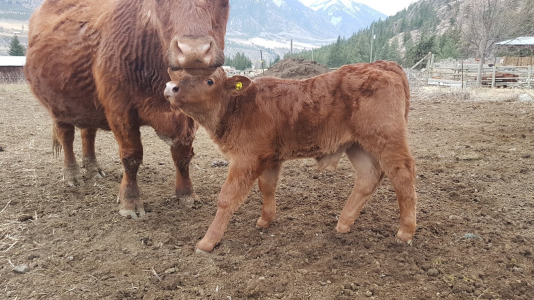
Sire at 6 months
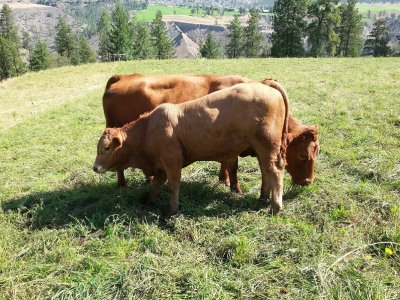
Sire's full brother
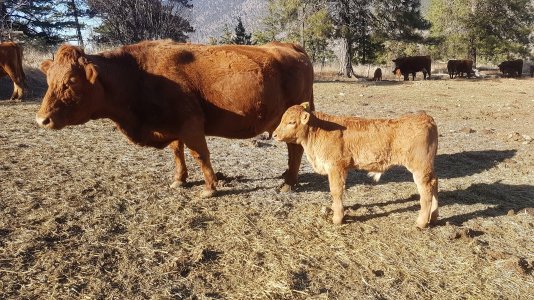
Their sire (Hector) (1/2 GV, 1/4 SH, 1/4 Herf) was also a homeraised bull and both are linebred (same grandsire on both sides of the family and same great-grandma)
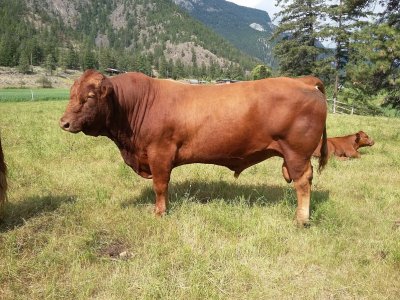
This is the sire of the other calves, the PB Gelbvieh that I bought
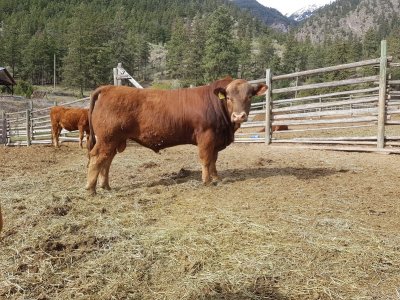
Ky hills
Well-known member
May not be the in style way to do it, but I reckon I started shopping for a bull for next year today in our barn while working cattle. Left a purebred Hereford calf a bull at least for now. Will take another hard look at weaning. We select a bull calf or two each year. It is a pretty good insurance policy in case something happens to and an older bull needs replacing. I select from cows that are consistently earlier in the calving time or occasionally from a heifer of one of those cows. This is a picture of the calf from the other day.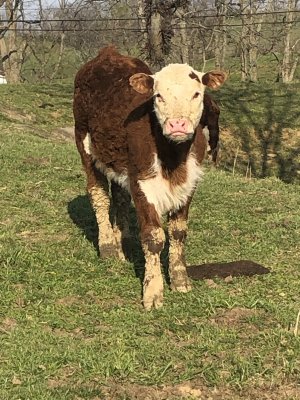

Nkline
Well-known member
You need to look into genetic recombination. You don't necessarily inherit 25% of your genetics from each grandparent (without throwing mitochondrial dna into the mix), 25% is a theoretical average but the real range is more like 17-34%. So some grandparents are more related than others, throw in selection pressure and you can alter percentages of influence over time.Simmental is a good example of a breed that is no longer purebred, as like you say, they are "up breeding to turn the cattle black. Simangus are in fact, crossbreds. I assume you are talking about Balancers when you said Gelbvieh, These can be 75% to 25 % Gelbvieh and the rest red or black Angus, This is not a stablized breed yet. Black Hereford and Brangus are established breeds. BH's are 5/8th Herford and 3/8th Angus., Br are 5/8 angus and 3/8 Brahma. Breed a Brangus to a Brangus, and you get a Brangus. Cattle have 60 chromosomes.. 29 pairs that make a Hereford a Hereford, or a Black angus a Black angus, and 1 pair of sex chromosones. So if you breed a herford to angus, the calf.. black baldy..has 1 set of angus Chromosomes and 1 set of Hereford chromosomes. Half a black baldy's eggs will have a full set of Hereford chromosomes, and half will have Angus. Same with a black baldy bull. If you breed a black baldy cow to a black baldy bull, 25% of the caves will be full blooded angus, 50% will be black baldies, and 25% will be a red hereford. Breed a Black hereford to a Black hereford, and 100% of the calves will be Black Hereford.
For a new breed to be developed from a 2 way cross, it is 3 generations. For example, when they developed Brangus. The first cross was a full blooded Brahma to a full blooded Angus, This is called F1. Then they took the 12/Br 1/2 Ang, and bred them back to Angus. This produced a 3/4 angus and 1/4 Brahma. ..these are F2. These were then bred back to 1/2 Angus and 1/2 Brahma, and those calves were 5/8ths Angus and 3/8ths Brahma, and they now have their own genetic material in their 29 pairs of BRANGUS chromosomes. Breeding a Brangus to a Brangus can never result in a Brahma calf or an Angus calf.